Hello, students! Welcome to our solutions for Unit 5, Chapter 14 Poem – ‘Kites.’ We’re thrilled to guide you through this delightful poem and help you explore its meaning and lessons. Our team of English experts, with training both in India and abroad, is here to address all your queries and make learning enjoyable and enriching.
Good luck!
Find Solutions to NCERT Class 6 English Poorvi Unit 5 Culture and Tradition Chapter 14 ‘Kites,’ here.
Let us do these activities before we read. (Page 141)
1. Answer the following questions and share them with your teacher and classmates.
(a) Have you ever flown a kite or seen someone fly it? Where? When?
Answer:
Yes, I have flown a kite in a park during a local kite-flying festival on 15th August last year. It was a lot of fun, and there were many people flying kites of different shapes and colours.
(b) Describe the kite—colour(s), shape, design of tail, any other detail.
Answer:
My kite was a bright green and red diamond shaped one. It had a long tail with blue and yellow streamers.
(c) What did you think when you saw the kite up in the sky?
Answer:
I felt thrilled watching the kite soar so high. It looked like it was dancing in the wind, and I felt proud that I was able to handle it so smoothly.
2. Search the internet for videos on Kite Festivals and watch them with your teacher and classmates.
(a) Share the things with your teacher that you saw and what the people were doing.
Answer:
In the videos on kite festivals that I watched, people were gathered in big open fields to fly kites of all shapes, sizes and colours. Some kites were huge and shaped like animals, while others were small and simple. I liked one which looked like a dragon and there were many kites having other interesting shapes too. The atmosphere was lively, with music and people cheering for the kites which soared the highest. As the kites soared higher, they grew smaller and smaller till they looked like tiny specks in the bright blue sky. Some boys were engaged in a kite fight. They tried to cut their opponent’s kite string with their own string. It took a lot of deft manoeuvring, but the thrill of cutting a kite was unbeatable.
(b) Would you like to participate in this kind of festival? Why?
Answer:
Yes, I would love to participate in a kite festival because it looks like so much fun. It would be amazing to be part of a big group all enjoying kite-flying together. We would compete against each other to see whose kite soared the highest, or have thrilling kite fights when we would enjoy cutting each other’s’ kites.
(c) What kind of kite would you like to fly?
Answer:
I would like to fly a kite shaped like a fire breathing dragon with bright colours and a long tail.
3. Look at the picture and complete the sentences. Share your responses with your teacher.
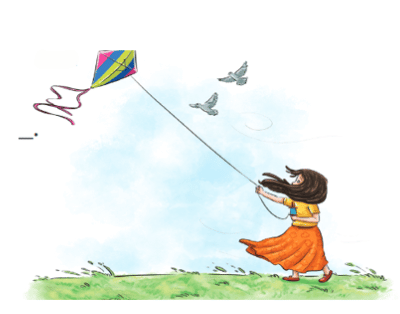
| windy | kite | flying | birds | sky | looking | has ribbons |
(a) I can see ___________, ___________ and ___________ in the picture.
Answer:
I can see a kite, birds, and the sky in the picture.
(b) The weather in the picture is ___________.
Answer:
The weather in the picture is windy.
(c) The kite is ___________ high in the sky.
Answer:
The kite is flying high in the sky.
(d) The child is ___________ from below.
Answer:
The child is looking from below.
(e) The tail of the kite ___________.
Answer:
The tail of the kite has ribbons.
4. Now, think and answer.
(a) List two more things that you want to add to the picture.
Answer:
I would like to add some clouds and a bright sun shining in the sky.
(b) If I were the child, I would ___________.
Answer:
If I were a child I would try and make my kite soar higher still.
(c) If I were the kite, I would ___________
Answer:
If I were a kite I would soar up high and let the wind carry me far away while I admire the view from above.
Let us discuss (Page 143)
1. Read the poem silently. As you read, mark the given statements as True or False.
| Statements | T/F |
| (a) The child is looking at the kites. | |
| (b) The kites look like birds of different colours. | |
| (c) It was a rainy day. | |
| (d) The child wants to be like a kite. | |
| (e) The child wishes to climb on a kite. | |
| (f) The kite is made of cloth and plastic. | |
| (g) The child wants to ride the kite. | |
| (h) The child knows they would have fun. | |
| (i) The child wants to look at the kite from a rooftop. | |
| (j) The child wants to look at people down below.. | |
| (k) The child knows that the people would stare. |
Answer:
| Statements | T/F |
| (a) The child is looking at the kites. | True |
| (b) The kites look like birds of different colours. | True |
| (c) It was a rainy day. | False |
| (d) The child wants to be like a kite. | False |
| (e) The child wishes to climb on a kite. | True |
| (f) The kite is made of cloth and plastic. | False |
| (g) The child wants to ride the kite. | True |
| (h) The child knows they would have fun. | True |
| (i) The child wants to look at the kite from a rooftop. | False |
| (j) The child wants to look at people down below. | True |
| (k) The child knows that the people would stare. | True |
2. Complete the following sentences.
(a) The poet says that the kites are like coloured birds –
See the kites fly/Like coloured birds in the sky.
The kites have been compared to b __ __ __ __ because they ______________.
Answer:
The kites have been compared to birds because they are colourful and fly high in the sky.
(b) The child wishes to be like air – I wish I were small / and as light as air.
The child wishes to be as l __ __ __ t as __ __ __. The child wishes this to be able to c __ __ m __ on a kite and fly.
Answer:
The child wishes to be as light as air. The child wishes this to be able to climb on a kite and fly.
| The poet uses simile in (a) and (b) to compare the kites with coloured birds and the quality of being light as air. The poet uses ‘like’ and ‘as’ to compare. |
Do you think that the use of simile in this poem helps us imagine better when we read the poem? Share your thoughts with your teacher and classmates.
Answer:
Yes, using similes in this poem helps us imagine the scene more vividly. When the poet compares the kites to “coloured birds,” it helps us visualise the kites as bright and lively, like real birds flying in the sky. Also, when the poet says he wants to be “as light as air,” it makes us imagine what fun it would be to experience weightlessness and float freely up with the kite. These comparisons make it easier to picture what the poet is describing.
3. Find a set of words from the poem that begin with the same consonant sound.
Stanza 1
Which consonant sound do both words begin with?
Answer:
Wind-whipped – both words begin with the consonant ‘w’
Stanza 3
Which consonant sound do both words begin with?
Answer:
wild wind – both words begin with the consonant ‘w’
This is called alliteration. For example, big bright blue bag, funny fan,etc.
Create 4 other sets of words using alliteration.
Answer:
Memorable moments
Sweet smile
Big bouncy ball
Tall twisted tree
Running round and round
4. In the last stanza, the two words that the poet repeats are __________,
__________ to tell us that the kite is flying __ __ __ y high.
Answer:
In the last stanza, the two words that the poet repeats are high, high to tell us that the kite is flying very high.
5. Study each stanza and underline the rhyming words from the end of each line. Also, circle the end words in the stanzas that do not rhyme.
Answer:
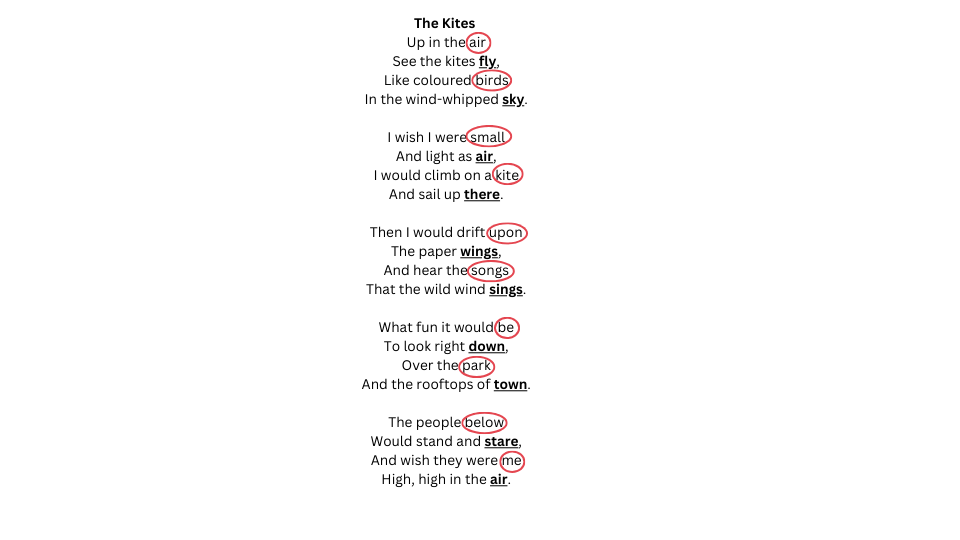
Let us think and reflect (Page 144)
1. Read the given lines from the poem and answer the following questions.
What fun it would be
To look right down,
Over the park
And the rooftops of town.
(a) Circle the word that does not share the same feeling as ‘fun’:
joy, excitement, care, happiness.
Answer:
Care
(b) Which line tells us that the poet was somewhere above?
Answer:
“To look right down,
Over the park
And the rooftops of town.”
This line suggests the poet imagines being high in the air, looking down at everything below.
(c) Choose the scene the child saw.
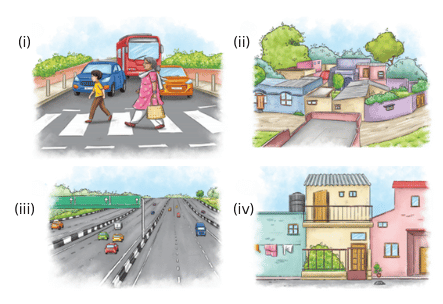
Answer:
The second picture matches the description of the child who imagines that he would look down” over the park and the rooftops of town” as he flies on a kite.
2. Answer the following questions.
(a) How does the poet describe the kites in the first two lines?
Answer:
In the first two lines of the poem, the poet describes the kites as flying high in the sky like colourful birds.Theyare tossed around by the strong wind.
(b) Why does the child say that they have to climb a tree first to get onto the kite?
Answer:
Perhaps the child imagines that to be able to reach and ride on a kite, he would need to reach up from a high place, like a tree. Climbing the tree would bring him closer to the kite, and allow him to step onto it and fly away.
(c) What are the songs that the child hears when flying atop the kite?
Answer:
The child imagines hearing the “songs” of the wild wind. These “songs” refer to the whistling of the wind as it blows and tosses around the kites high in the sky.
(d) Why did the people look up at the child and stare? If you looked up and saw that, what feelings would you have?
Answer:
People looked up and stared in amazement at the unusual sight of a child flying astride a kite. If I looked up and saw the sight, I would be amazed and envious too, wishing that I could also share the experience.
(e) If you were the kite carrying the child high up in the air, what would you tell them?
Answer:
If I were the kite carrying the child high up in the air, I would advise him to hold on tight and enjoy the ride across the bright blue sky. I would tell him not to panic and be prepared for all kinds of sudden motions just as he does when he takes a roller coaster ride.
Let us learn (Page 146)
1. Look at the picture of the kite and read what some of its parts are named.
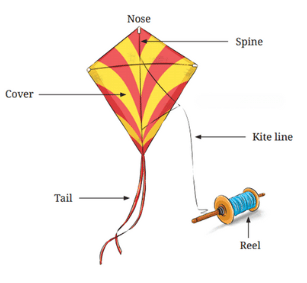
Now, complete the given conversation by filling in the blanks with some ‘parts of a kite’ words from above.
Bina: I love the long yellow t _ _ _ at the end of my kite. What colour is your kite?
Saroj: My kite’s c _ _ _ _ is pink. The s _ _ _ _ e is black.
Bina: Oh wonderful! My kite l _ _ _ is red. The r_ _ l that wraps it is green. I like it.
Saroj: My kite line is red too. The tip of my kite has a blue _ _ _ e.
Bina: Beautiful! Let’s go and fly our pretty kite.
Answer:
Bina: I love the long yellow tail at the end of my kite. What colour is your kite?
Saroj: My kite’s cover is pink. The spine is black.
Bina: Oh wonderful! My kite line is red. The reel that wraps it is green. I like it.
Saroj: My kite line is red too. The tip of my kite has a blue nose.
Bina: Beautiful! Let’s go and fly our pretty kites.
2. Let us create a poem using words in a kite!
| The first line is the subject. Keep this to one word. Use a noun. | Kite |
| The second line is two describing words for the noun. | pretty, colourful |
| Line three includes three action words. | flying, floating, soaring |
| Line four uses two words that describe the action words. | quickly, happily |
| Line five is one word that has the same meaning as the subject/synonym. | paper-bird |
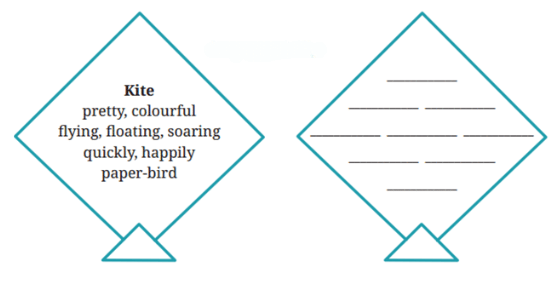
This is called a cinquain poem. It is a five-line poem that describes a person, a place or a thing. Now, create a cinquain poem yourself on anything you like.
Answer:
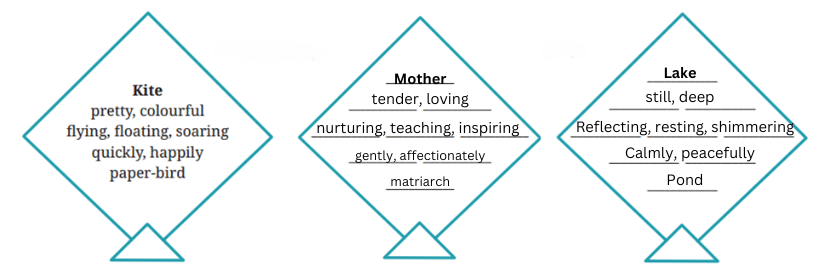
3. The poet uses the word ‘fly’ and ‘drift’ to tell us about the kite’s movement.
(a) Circle the words matching the ‘drift’ movement. You can choose more than one word.
| slow | fast | quick | upward |
| downward | Round and round | float |
Answer:

(b) Study some other words about the kite’s movement and share what type of movement they show. You can look at (a) for the type of movement.
| glide | dive | soar | swoop | circle |
Answer:
Here are descriptions of the kite’s movements based on the words provided:
Glide: A smooth, steady movement, similar to drifting or floating smoothly and gently through the air.
Dive: A fast, downward movement, where the kite drops quickly.
Soar: An upward, powerful movement, suggesting that the kite is flying high with strength.
Swoop: A quick, curved movement, where the kite dips and then rises.
Circle: A round and continuous movement, where the kite goes around in loops or circles.
Each word gives a different sense of how the kite moves in the sky!
4. The poet has used expressions like—
up in the air; look right down; sail up there; stand and stare
(a) Read how these expressions are used in the poem.
Answer:
Here’s how the expressions are used in the poem:
Up in the air: “Up in the air/See the kites fly,” – “Up in the air” describes the flight of the kite high in the sky.
Look right down: “What fun it would be/To look right down, /Over the park/And the rooftops of town.” – “Look right down” means that the child would be able to view everything from above, looking down at the park and rooftops.
Sail up there: “I would climb on a kite/And sail up there.” – “sail up there’ implies that the child would like to sail in the sky just like the kite without coming down.
Stand and stare: “The people below/Would stand and stare, /And wish they were me/High, high in the air.” – “Stand and stare” refers to the people on the ground who are amazed by the sight of the child flying high astride a kite.
(b) In pairs, make sentences using these expressions. Discuss with your teacher and then write in your notebooks.
Answer:
Up in the air: We waited at the airport until my mother’s plane was up in the air.
Look right down: From the terrace we could look right down at the neighbour’s yard.
Stay up there: The cat was afraid of coming down from the tree, so it stayed up there till it was rescued by father.
Stand and stare: People in Simla stand and stare at the glorious sunsets in autumn.
Let us listen (Page 148)
Hello everyone! I’m happy to share with you some details about the Kite Festival. It is a popular festival in India and it takes place during Makar Sankranti in the month of January.
People can even be seen flying kites from their terraces and rooftops and taking part in kite flying competitions. This festival is celebrated as Uttarayan in Western India.
The festival gives everyone a chance to look at kites of different shapes, sizes and colours. Gujarat is the main centre of celebrations but Uttarayan is also celebrated in Rajasthan
and Telangana.
In Karnataka, the Tourism Department has also been organising the kite festival once each year. Punjab also celebrates this festival of kites during Baisakhi and Basant Panchami.
Kite flying is a tradition that is deep-rooted in Indian culture and the Kite Festival is one that is eagerly awaited.
This is also a reason why people across India also fly kites to celebrate Independence Day. Happy kite-flying to all of you!
Listen about the Kite Festival in India. As you listen, circle the words that are not correct. Then, listen again and write the correct words. (refer topage 163 for transcript)
(a) Kite Festival is celebrated during the month of June.
(b) The International Kite Festival is named Uttarayan in Eastern India.
(c) Uttarayan is mainly celebrated in Gujarat, but also in Maharashtra
and Telangana.
(d) During the Kite Festival, we can see kites of different shapes, sizes
and colours.
(e) In Karnataka, the Tourism Department organises the kite festival
every year.
(f) The Punjab region celebrates Basant Panchami and Baisakhi by
flying kites.
(g) People of India also enjoy flying kites on Earth Day.
Answer:
(a) Kite Festival is celebrated during the month of June.
Answer:
January
(b) The International Kite Festival is named Uttarayan in Eastern India.
Answer:
Western India
(c) Uttarayan is mainly celebrated in Gujarat, but also in Maharashtra and Telangana.
Answer:
Rajasthan
(d) During the Kite Festival, we can see kites of different shapes, sizes and colours.
Answer:
Correct
(e) In Karnataka, the Tourism Department organises the kite festival every year.
Answer:
Correct
(f) The Punjab region celebrates Basant Panchami and Baisakhi by flying kites.
Answer:
Correct
(g) People of India also enjoy flying kites on Earth Day.
Answer:
Independence Day
Let us speak (Page 149)
Share a kite-flying experience with your classmates. If you have not flown a kite yet, share an experience of watching kites fly. Give details—Where? When? Why? How? Speak in complete sentences.
Answer:
I remember a special day during Makar Sankranti, a January festival when people celebrate by flying kites. My family and I joined the festivities from our rooftop. The sky was filled with kites of every colour and shape. Nervous about flying my first kite, I followed my older cousin’s guidance. He showed me how to hold the spool firmly and release the string gradually to let the kite catch the wind. At first, my kite struggled, but a steady gust soon lifted it high. I learned how to control the kite by adjusting the string in response to the wind. Watching it soar, I felt proud, thrilled, and connected to the joyful tradition of kite flying, even though my arms tired quickly. it was an incredible experience. I understood then why so many people love kite flying.
Let us write (Page 149)
1. Imagine yourself as a kite. In pairs, first discuss all the following hints.
• What shape of kite are you? What colours do you have? What other parts of yourself are you happy about?
Answer:
I am diamond shaped. My cover isred, yellow, and blue. My nose is fluorescent green. I am happy about my long tail which is decorated with colourful bows. My body is made of paper and my frame is strong.
• Where are you? Who do you belong to? What activities do you do? Who are your friends?
Answer:
I am floating above a field. I belong to a boisterous little boy. I twist and twirl, soar, dive and swoop with the wind. The other kites flying with me are all my friends.
• Do you have any message for humans?
Answer:
My message to humans is to enjoy the simple pleasures of life.
2. Now, write a paragraph of about 100 words, with the title—I am a Kite.
Answer:
I am a Kite
I am a diamond-shaped kite whose cover sports vibrant shades of red, yellow, and blue while my fluorescent green nose sparkles in the sun. My long tail, adorned with little colourful bows, dances in the breeze. I feel proud of my sleek paper body and sturdy frame. I belong to a boisterous little boy. He brings me to a wide, open field, where I soar high in the sky with my friends, the other kites. We twist, twirl, soar, dive, and swoop laughing with the wind. My message to humans is to feel free and enjoy the simple pleasures of life, just as I do when I glide through the air.
Let us explore (Page 149)
1. The mention of kites exists in ancient Indian texts. It can be found in the poetry of the thirteenth-century Marathi saint and poet, Namadeva. In his poems or gathas, he called a kite a gudi, and there is a mention that the kites were made from kaagad (paper).
2. Have a look at some of the different types of kites. Choose which one is commonly seen.
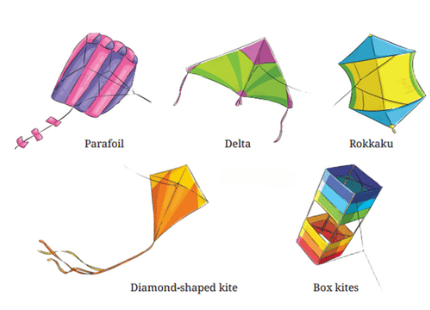
Answer:
The diamond-shaped kite is commonly seen.
(a) Find out the steps to make a kite.
Answer:
Steps to Make a Kite
Materials Needed:
A large sheet of paper or light plastic (25 x 25 inches)
Two wooden dowels (one 20 inches long, the other 24 inches)
Strong string or kite string (about 50 feet for flying) wrapped round a reel
Scissors
Clear tape or glue
Ruler
Markers or paint for decoration
Instructions:
Prepare the Frame:
Take the 24-inch dowel (for the vertical spine) and the 20-inch dowel (for the horizontal crosspiece).
Measure 6 inches from the top of the 24-inch dowel, and place the 20-inch dowel at this point to create a “T” shape.
Tie the dowels together tightly at the intersection with string, securing them with tape or glue for extra stability.
Attach the Paper:
Place the dowel frame over the paper or plastic sheet.
Cut the paper into a diamond shape, with about 1-inch extra around the edges to fold over the dowels.
Fold the edges of the paper over the dowels and secure them with clear tape or glue. This will give your kite its shape and keep it lightweight for flying.
Attach a Tail:
Cut a piece of string about 4 feet long for the tail.
Add small strips of paper or ribbon (4-6 inches long) every 6-8 inches along the tail to add weight and stability.
Attach this tail to the bottom of the kite’s spine with tape or by tying it on securely.
Attach the Flying String:
Tie a long piece of strong kite string (about 50 feet) to the point where the dowels cross. This will be your main flying string.
For better control, you can also attach an additional short piece of string (6-8 inches) tied at both ends of the horizontal dowel. Then, tie your main flying string to the midpoint of this string for better balance.
Decorate:
Use markers, stickers, or paint to add colourful designs to your kite!
(b) Follow the steps and create your own kite. Get it to school to show your teacher and classmates.
Answer:
Carry the kite made by you to school to show off how beautiful it is. Maybe you could get permission from your teacher to fly it from the games field. All those who made kites can fly them together and enjoy the thrilling experience together.
(c) Write a message on the kite.
Answer:
Message
“Kites rise higher against the wind – not with it.”
Once your kite is finished, test it outside in a light breeze, and then bring it to school. Your classmates and teacher will be thrilled to see the kite you’ve created! Enjoy the process and happy flying!
Frequently Asked Questions (FAQs) on NCERT Class 6 English Poorvi Unit 5 Culture and Tradition Chapter 14 ‘Kites’
We have seasoned English experts on staff who have taken care to explain the poem to you in a lucid and easy-to understand manner. Solutions to all end text questions and in-text activities have been provided which cover the poem in detail and help you focus on the important aspects of the poem.
You can also download the free PDFs of the solutions anytime you please! We will keep providing you with plenty of top-quality study material and resources to help you prepare. So, make sure you keep visiting our website and join our email list to take advantage of them! (insert hyperlink)
Yes indeed! You can download the free PDF versions of these excellent solutions anytime (please look towards the top of the page)!
Our experienced English faculty have crafted these solutions which guide you to notice every detail of the poem. We advise you to go through the poem at first and look up the meanings of words that you might not know. This step must not be skipped as it will not only help you to understand the poem better, but also enrich your vocabulary to a great extent.
Then you need to go through all the answers we have thoughtfully provided – both to the questions at the back of the book as well as the in-text questions and activities in order to grasp the essence of the poem. Pay close attention to details. Do not memorise because understanding the text is the key to learning.
Subsequently, you need to practise writing down the answers within a specific time frame. You can then ace your exams! There is no short cut to success! Systematic study will help you achieve what you want.
Feeling lost or anxious about your studies and future? We understand how overwhelming it can be to face these challenges alone. But don’t worry, you’re not alone—and we’re here to help.
At educationroundtheworld.com, we connect you with dedicated teacher-mentors who are passionate about guiding students like you toward success. Our mentors are committed to helping you navigate your journey with clarity, offering the support you need to achieve your goals.
Book your first session with us, and we’ll begin the process of creating a customized study plan that suits your unique needs and aspirations. Together, we’ll focus on building your confidence and skills so you can move forward with a clear, actionable plan for success.
Say goodbye to the stress and uncertainty—let’s work together to pave the way for your bright future, starting today!
Take the first step now—reach out to us and unlock your full potential!


